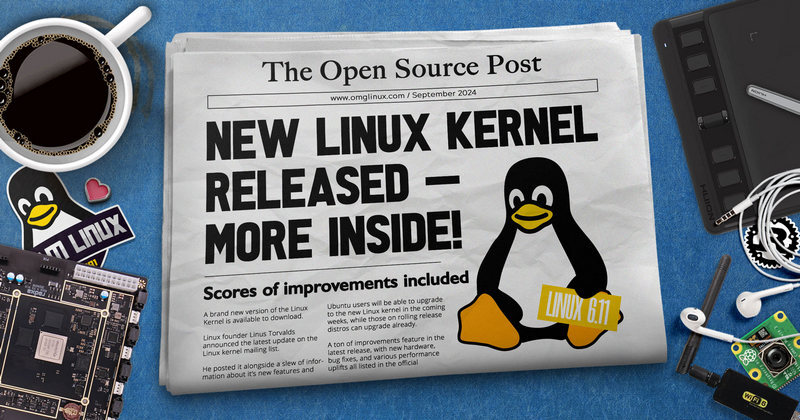 Linus Torvalds heeft versie 6.13 van de Linux Kernel vrijgegeven. De kernel is het hart van het besturingssysteem en zit, simpel gezegd, als laag tussen de hardware en de applicaties in. De nieuwe uitgave bevat de gebruikelijke hoeveelheid aan verbeteringen. Meer informatie kan bij 9to5Linux en OMG Ubuntu worden gevonden.
Linus Torvalds heeft versie 6.13 van de Linux Kernel vrijgegeven. De kernel is het hart van het besturingssysteem en zit, simpel gezegd, als laag tussen de hardware en de applicaties in. De nieuwe uitgave bevat de gebruikelijke hoeveelheid aan verbeteringen. Meer informatie kan bij 9to5Linux en OMG Ubuntu worden gevonden.
Linux 6.13 ReleasedHighlights of Linux 6.13 include lazy preemption support to simplify kernel’s preemption logic, support for running Linux in protected virtual machines (a.k.a. realm) under the Arm CCA (Confidential Compute Architecture), user-space shadow stack support for AArch64 (ARM64) via Guarded Control Stack (GCS), support for 6-node sub-NUMA clustering on Intel, and split-lock detection support for AMD CPUs.
Linux kernel 6.13 makes the amd-pstate cpufreq driver the default on some newer AMD Epyc processors, adds support for thermal thresholds that can be added and removed from user space via netlink along with a related library update, and implements a new feature in the character device uAPI to notify the user-space about changes triggered by in-kernel users.
In addition, it adds PMU support for Intel ArrowLake-H CPUs and Intel Panther Lake processors, a new ACPI backlight quirk for Apple MacbookPro11,2 and Air7,2, support for the MIPI DisCo 2.0 specification in the SoundWire subsystem, a new pass-through mode for audio-related accelerators, and support for hardware superpages in the V3D driver used for Raspberry Pi computers.
Furthermore, Linux 6.13 enables the “Lazy preemption” model (CONFIG_PREEMPT_LAZY=y) for x86, RISC-V, and LoongArch architectures, which optimizes fair-class preemption by delaying preemption requests to the tick boundary, and adds per netns RTNL (disabled by default) for networking.
In terms of networking, the Linux 6.13 kernel converts the RTNL (Routing Netlink) lock into a per-network-namespace lock to reduce contention in namespace-heavy workloads, implements a new mechanism called IRQ suspension to suspend IRQs during application busy periods, adds support for per-NAPI config via netlink, and introduces a TX H/W shaping API to control traffic shaping.
Filesystem-wise, the F2FS file system received a device aliasing feature where you can carve out partitions but reclaim the space by deleting aliased files in the root directory, while the XFS file system received basic support for atomic write operations. On the other hand, the FUSE file system received page-to-folio conversions and support for configuring the maximum size of FUSE requests with a sysctl.
Moreover, the EXT4 file system received a lot of miscellaneous bug fixes and cleanups, the Btrfs file system received a performance boost by reducing lock contention when traversing extent buffers and reducing extent tree lock contention when searching for inline backref, while the exFAT file system received a performance boost by reducing FAT chain traversal.
As expected, Linux kernel 6.13 brings enhanced hardware support with new and updated drivers for various devices, including the Vexia EDU ATLA 10 and Surface Pro 9 5G tablets, Adreno A663 GPU chipset, Allwinner H616, AMD ACP 6.3, Qualcomm SM8750, and RealTek RT721 audio chips, NT36672A touchscreens, AMD I3C controllers, NVIDIA Mellanox “MLX5” network devices, and others. There’s also a new virtual-cpufreq driver for guest kernels to improve the performance and power of workloads for virtual machines.
Last but not least, Linux 6.13 brings real-time computing capabilities to the LoongArch architecture, as well as support for pointer masking in userspace, it brings support for probing vector misaligned access performance and support for qspinlock on systems with Zacas and Zabha for the RISC-V architecture, and adds support for trace events in Rust, along with a new memory allocator.
You can download Linux kernel 6.13 right now from Linus Torvalds’ git tree or the kernel.org website if you fancy compiling it on your GNU/Linux distribution. However, I recommend waiting for the new Linux release to arrive in your distro’s stable software repositories before updating your kernel.
With Linux 6.13 out the door, the merge window opens for the next major kernel branch, Linux 6.14, which is expected to see the light of day in stable form at the end of March 2025. Until then, a first Release Candidate (RC) development version will be available for public testing in two weeks, on February 2nd.


:strip_exif()/i/1274122604.png?f=thumbmedium)